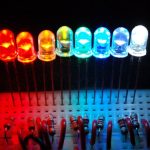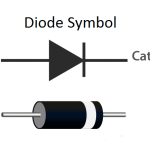Drive Current Vs Light Output
For high values of forward drive current the temperature of the PN junction of semiconductor increases due to considerable power dissipation. This type of rise in temperature at the junction results in decrease in the efficiency of radiative recombination. As a result, the density of current is further increased; internal series resistance will tend to reduce the light emitting efficiency of any light source.
Quantum Efficiency
The Quantum efficiency of any light source is defined as the ratio of the radiative recombination rate, which emits light to total recombination rate and it is given as
η=Rr/Rt
Switching Speed
The switching speed of a light source resembles how fast a light source can turn on and off by an applied electrical supply to produce a corresponding pattern of optical output. LEDs have slow switching speed than usual LASER diodes.
Spectral Wavelength
The peak spectral wavelength is defined as the wavelength at which the maximum intensity of light is generated. It is determined by the energy band gap of the semiconductor material used in LED manufacturing.
Spectral Width
The spectral width of a light source is defined as the range of wavelengths over which a light source emits light. The light source has to emit light within the narrower spectral width.
LED I-V Characteristics
Before emitting light from any light emitting diode, it needs to have current to flow across it, since LED is a current dependant device with its output light intensity being directly proportional to the forward current passing through the LED.
Light emitting diode has to be connected in a forward bias combination across the power supply and it should be current limited by using a resistor connected in series to protect it from the excess current flow. LED should not be connected directly to the battery or power supply because excess amounts of current will flow through it and LED may damage.
Each LED has its own individual forward voltage drop along the PN junction and this parameter has been determined by the semiconductor material used in manufacturing of LED for a specified amount of forward conduction current, usually for a forward current of about 20mA.
At low forward voltages, the driving current of the diode is dominated by the non-radiative recombination current due to recombination of charge carriers across the length of the LED chip. At higher forward voltages, the diode driving current is dominated by the radiative diffusion current. Even at larger voltages than the usual, the diode current is limited by the series resistance. The diode should never reach to reverse breakdown voltage for a short duration of time since permanent damage of the diode may occur. The below figure shows the I-V characteristics of the different color LEDs.



